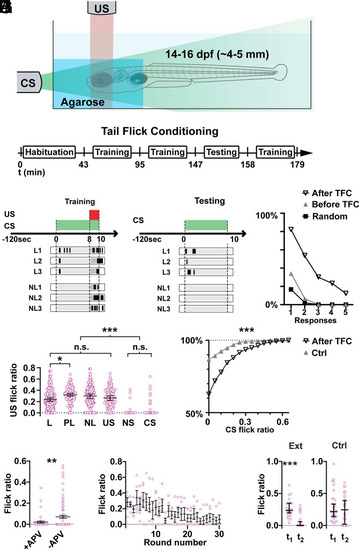Fig. 1
- ID
- ZDB-FIG-230204-34
- Publication
- Dempsey et al., 2022 - Regional synapse gain and loss accompany memory formation in larval zebrafish
- Other Figures
- All Figure Page
- Back to All Figure Page
|
Tail Flick Conditioning (TFC), a CC paradigm for larval zebrafish. (A) The head of the zebrafish undergoing TFC is encased in low-melt agarose, leaving the tail free to move. The CS consists of light from a green LED; the US is heat produced by an NIR laser. The CR is tail flicking. (B) Timeline of the TFC paradigm. (C) During training, fish are exposed to both the CS and US. In response to the US, all fish flicked their tails vigorously (black bars). Here, we display late-stage training rounds for three L and three NL fish. (D) During the testing phase of TFC, the fish is exposed to the CS alone. L respond immediately upon presentation of CS; NL do not. Here, early-stage testing rounds are shown. (E) Cumulative histogram of the percentage of larval zebrafish that respond with tail flicking to the five CSs presented during testing one or more times, two or more times, etc. (After TFC, inverted triangles). The baseline flicking histograms from fish during the final rounds of Habituation (Before TFC, gray triangles) or from fish assayed after TFC for five time windows when no stimulus is present (Random, filled squares) are different. (F) The FR (fraction of time tail is flicking) when US is presented during training are similar for L (n = 11 fish), PL (n = 6), NL (n = 11), and US only (US, n = 11) and different from the FR during the same time period for fish exposed to CS only (n = 11) or NS(n = 11; ***P < 0.005, *P < 0.05, Kruskal–Wallis test). No pairwise comparison between L, PL, NL, or US is significant except for L versus PL (*P < 0.05, Kruskal–Wallis test). (G) The FR in response to the CS during testing is significantly different in fish exposed to TFC versus control fish (***P < 0.0001, Kolmogorov–Smirnov test). Cumulative probability distributions are shown. (H) The FR (averaged for all fish during testing) is significantly reduced in fish exposed to 2-amino-5-phosphonovaleric acid (APV) during TFC compared to control fish (n = 12 fish +APV, 19 fish −APV; **P < 0.01, Mann–Whitney U test). Each data point represents the response to a single presentation of the CS. (I) The FR diminishes over 30 presentations of CS alone (extinction, n = 5) in a set of L fish by ∼75%. (J) FR before and after extinction (Ext, t1 and t2) are significantly different (***P < 0.005, n = 5 as in H, Mann–Whitney U test). FR at t1, t2 without extinction (n = 6) are not significantly different (P > 0.05, Mann–Whitney U test). Data available at https://doi.org/10.25551/1/1-1YZE (45). |

